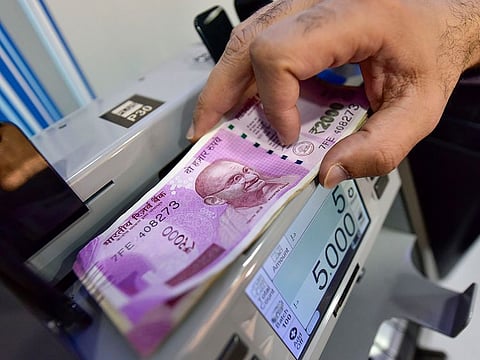India rupee, stocks trade lower after Reserve Bank maintains interest rate at 6.5%
RBI maintains repo rate at 6.5% and cites high inflation

Dubai: The India rupee continues to trade at all-time lows of 22.85 to the dirham (83.95 to the dollar) after the central bank retained its base interest rate at 6.5 per cent. The main Indian stock market index BSE too is down in the dumps, lower by around 300 points and erasing some of the gains it had made yesterday (August 7).
“The INR dropping to 23 against the dirham may not be too far away,” said Neelesh Gopalan, senior FX analyst. “It has already slipped 1.52 per cent in the year to date, and has been hitting new all-time lows in recent days.”
For Indian expats in the UAE and Gulf, the current INR-AED levels couldn’t be better. The last few days had seen ‘record’ remittances to India as they made full use of the successive all-time lows.
The rupee was at 22.70-22.73 level in the last couple of months before slipping to 22.77 on July 19.
The RBI has at various times intervened to shore up the INR from too steep or rapid a decline. But there are many FX traders who believe that 23 to the dirham is now a question of 'how soon' rather than whether it will happen.
Indian mutual fund investors should look to top up their investments at this juncture to get better value.

RBI sticks to rates
As for the RBI and the rates, it was widely expected that they would hold it at 6.5 per cent given the inflation numbers. The central bank is projecting inflation at 4.4 per cent for the second quarter (July-September) of the 2024-25 financial year against the earlier estimate of 3.8 per cent. This, according to the RBI Governor, Shaktikanta Das, has much to do with the rising food prices.
So, how soon will India go for a rate increase? Will they shade what the US Fed will likely do, by opting for a hike in September? According to Krishnan Ramachandran, CEO of Barjeel Geojit Securities, "I expect the RBI to maintain the interest rate (at 6.5 per cent) for at least one more quarter since inflation is expected to moderate around September/October.
"At this juncture, the fall/correction in the Indian stock markets has created opportunities to invest in sectors such as IT, pharma, renewable energy, banking and financial services, taking into account both short-term resilience and long-term growth potential."
The INR-AED level dropping further to 23 levels seems imminent rather than something for next year.

Consistency can be good
"Maintaining interest rates offers consistency in borrowing costs, which will prompt more aspiring homebuyers to consider taking the plunge - and thus drive demand in the housing market," said Anuj Puri, Chairman of Anarock Group. "With interest rates staying steady, EMIs will remain manageable for current and potential homeowners, potentially leading to increased home sales - particularly in the price-sensitive affordable segment."
BSE cuts losses
After the 300 point drop, the BSE manage to trim the losses closer to 11.45am UAE time. Currently, it is 50 points in the red as investors sized up what RBI's Das had to say about the macro economy and when a rate cut might happen. "Without price stability, high growth cannot be sustained," he said today while announcing the rate retention.
The India economy has the firepower, growing at 8 per cent plus during the current financial year. And then there is the $675 billion it retains as FX reserves.
So, what should investors be doing vis-a-vis their exposures to the Indian stock market? "Stocks of recently beaten down sectors like banks, metals, railway, defence and auto may see a strong revival," said Gaurav Katariya, founder of Mayukhi Investments.
"It is true that many stocks and sectors had a good correction (in recent days), but some are still overvalued. However, given the kind of fund inflows Indian markets are seeing at the moment, a short-term spike in stock prices can't be ruled out either. All in all, we may see volatility increasing further and price movements remaining shorter on both buying and selling sides.
"If this continues for a week or two from here, the weakness seen in export-oriented sector like IT may shift across other major sectors like auto, chemicals, realty, metals, and construction."
Sign up for the Daily Briefing
Get the latest news and updates straight to your inbox



